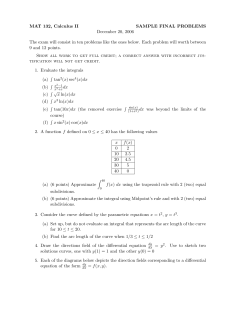
Name_________________________________________
Calculus Maximus WS 7.3: Separable Diff EQ Name_________________________________________ Date________________________ Period______ Worksheet 7.3—Separable Differential Equations Show all work. No Calculator unless specified. Multiple Choice 1. (OK, so you can use your calculator right away on a non-calculator worksheet. Use it on this one.)A sample of Kk-1234 (an isotope of Kulmakorpium) loses 99% of its radioactive matter in 199 hours. What is the half-life of Kk-1234? (A) 4 hours (B) 6 hours (C) 30 hours (D) 100.5 hours (E) 143 hours 2. In which of the following models is dy directly proportional to y? dt I. y = ekt + C II. y = Cekt III. y = 28kt 3t +1 ⎛ 1 ⎞ IV. y = 3 ⎜ ⎟ ⎝ 2 ⎠ (A) I only (B) II only (C) I and II only Page 1 of 6 (D) II and III only (E) II, III, and IV (F) all of them Calculus Maximus WS 7.3: Separable Diff EQ 3. (Use your calculator on this one, too, but get the exact answer first.) The rate at which acreage is being consumed by a plot of kudzu is proportional to the number of acres already consumed at time t. If there are 2 acres consumed when t = 1 and 3 acres consumed when t = 5 , how many acres will be consumed when t = 8 ? (A) 3.750 (B) 4.000 (C) 4.066 (D) 4.132 (E) 4.600 Free Response For problems 4 – 13, find the general solution to the following differential equations, then find the particular solution using the initial condition. 4. dy x = , y (1) = −2 dx y 5. dy x = − , y ( 4) = 3 dx y 7. dy = 2 xy , y ( 0 ) = −3 dx 8. dy = ( y + 5 )( x + 2 ) , y ( 0) = −1 dx Page 2 of 6 6. 9. dy y = , y ( 2) = 2 dx x dy = cos 2 y , y ( 0 ) = 0 dx Calculus Maximus 10. dy = ( cos x ) e y +sin x , y ( 0 ) = 0 dx 13. dy 4 y ln x , y (e) = 1 = dx x WS 7.3: Separable Diff EQ 11. dy = e x− y , y (0) = 2 dx For problems 14 – 17, find the solution of the differential equation conditions. 14. k = 1.5 , y ( 0 ) = 100 16. y ( 0 ) = 50 , y (5) = 100 Page 3 of 6 12. dy = −2 xy 2 , y (1) = 0.25 dx dy = ky that satisfies the given dt 15. k = −0.5 , y ( 0 ) = 200 17. y (1) = 55 , y (10 ) = 30 (divide one by the other) Calculus Maximus WS 7.3: Separable Diff EQ 18. AP 2010B-5 (No Calculator) dy x + 1 . = dx y (a) On the axes provided, sketch a slope field for the given differential equation at the twelve points indicated, and for −1 < x < 1 , sketch the solution curve that passes through the point ( 0, −1) . Consider the differential equation (b) While the slope field in part (a) is drawn at only twelve points, it is defined at every point in the dy xy-plane for which y ≠ 0 . Describe all points in the xy-plane, y ≠ 0 , for which = −1 . dx (c) Find the particular solution y = f ( x ) to the given differential equation with the initial condition f ( 0 ) = −2 . Page 4 of 6 Calculus Maximus WS 7.3: Separable Diff EQ 19. AP 2006-5 Consider the differential equation dy 1 + y , where x ≠ 0 . = dx x (a) On the axes provided, sketch a slope field for the given differential equation at the eight points indicated. (b) Find the particular solution y = f ( x ) to the differential equation with the initial condition f ( −1) = 1 and state its domain. Page 5 of 6 Calculus Maximus WS 7.3: Separable Diff EQ 20. AP 2005-6 dy 2x =− . dx y (a) On the axes provided, sketch a slope field for the given differential equation at the twelve points indicated. Consider the differential equation (b) Let y = f ( x ) be the particular solution to the differential equation with the initial condition f (1) = −1. Write an equation for the line tangent to the graph of f at (1, −1) and use it to approximate f (1.1) . (c) Find the particular solution y = f ( x ) to the given differential equation with the initial condition f (1) = −1. Page 6 of 6
© Copyright 2025





















